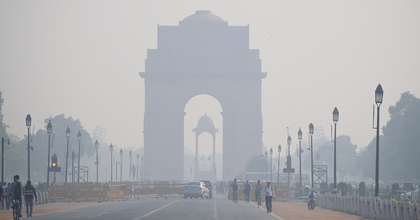The Environmental Protection Agency (US EPA or, more commonly, EPA) is an independent agency in the United States entrusted with the mission of protecting human health and the environment. You’re right to imagine that this can encompass many different things. They dedicate themselves to topics as diverse as air, water and land, chemicals and toxics, waste and cleanup.
While the EPA is an American agency, its influence reaches beyond the borders of the USA to countries all over the world, from Norway to Argentina and from Australia to Greenland. The national emission standards for countless countries find their origin in EPA legislation.
Until 2015, the EPA was not widely known to the average person outside the US. The Volkswagen emission scandal brought a radical change to that situation. Thanks to the EPA's scrutiny and persistence, the German car manufacturer confessed after a long period of denial that they had cheated with CO2 emission software installed in over 11 million vehicles.
EPA Regulations
EPA's work starts with gathering information. Their main data suppliers are other governmental bodies. Correct scientific data is paramount to understanding health and environmental issues and presenting solutions. While the EPA library is extensive, they also share their knowledge. Their primary task is to supply information to state, tribal, and local governments, but they also inform individuals, businesses, scientists, and legal bodies worldwide.
Based on accumulated data, EPA regulations are drawn up, explaining the technical, operational, and legal details necessary to implement laws. As a regulatory body, the EPA's powers are restricted; they can only act under statutes approved by the US Congress. Even so, they do have enforcement powers, including fines and sanctions.
Milestones
Since its establishment in 1970, the EPA can look back on a few impressive milestones relating to health and the environment:
- The Federal Water Pollution Control Act, enacted in 1972 and most commonly known as the Clean Water Act,
- The Federal Insecticide, Fungicide, and Rodenticide Act of 1972, to protect pesticide applicators, consumers, and the environment,
- The Resource Conservation and Recovery Act of 1976, which governs solid waste and hazardous waste disposal,
- The Emergency Planning and Community Right-to-Know Act of 1986, which was the positive response to the Chernobyl disaster,
- One of the most influential modern environmental laws is the Clean Air Act. While it had already passed the House and Senate in 1963, EPA drew up 5 major amendments, the last of which was finalized in 1990.
EPA's Efforts to Improve Air Quality
Protecting the ozone layer, reducing acid rain and toxic pollutants, and improving air quality and visibility are the top priorities on EPA's agenda relating to air quality. Test kits in conformity with EPA standards have been developed to detect pollutant concentrations in homes and working environments. Typically, these affordable devices check PM2.5 levels, VOCs, temperature, and humidity.
You may not always be able to see or smell when something is amiss. An EPA test can reveal if the air quality in a specific location is truly within specific standards.
A Concise EPA Wiki on Air Quality
Different indicators will show whether the air you live and work in is as healthy as it should be.
- Particulate Matter (PM): dust, dirt, soot, smoke, and other solid or liquid substances present in the air you breathe. 10 and 2.5 micrometres (or microns) are the most common measurements. PM2.5 poses a severe risk to health.
- Ground-level ozone (photochemical air pollution): puts particularly people with lung diseases in jeopardy.
- Nitrogen dioxide (NOx): a group of highly reactive gases, mainly produced when fuel is burned. The most important emissions come from cars, trucks and buses, power plants, and off-road equipment.
- Benzo[a]pyrene: the carcinogenic result of incomplete combustion at high temperatures of substances such as coal tar, tobacco smoke, and grilled meats.
- Volatile organic compounds (VOCs): these are in fact beneficial when produced by plants, animals, and microbes. The major sources of dangerous VOCs are paints, coatings, chlorocarbons, fossil fuel, benzene, etc. Although the concentrations are low, they cannot be dismissed as their true danger lies in their long-term health effects.
- Persistent organic pollutants (POPs): organic compounds that are not easily biodegradable. The most familiar ones are pesticides, solvents, and pharmaceuticals.
- Toxic heavy metals: cadmium, mercury, lead, arsenic, manganese, chromium, cobalt, nickel, copper, zinc, selenium, silver, antimony and thallium.
The Right to Clean Air in the Workplace
The right to clean air in the workplace is embedded in the Universal Declaration on Human Rights, adopted by the United Nations General Assembly in 1948.
Compliance Solutions by Plymovent
To protect workers, the EPA has provided the necessary basis for 3 pieces of legislation. Plymovent offers fitting solutions for compliance.
For the legislation on welding fume extraction, Plymovent provides various solutions:
- In response to fire legislation, the Plymovent SHIELD fire safety solutions reduce the chance of filter fires to a minimum. In the event of a fire, however, Plymovent detectors will pick up on the situation quickly. In most cases, sliding valves and FlameShield will get a fire under control swiftly, keeping any damage to a minimum.
In line with the legislation on exhaust extraction, Plymovent offers three fully automatic systems to clean the air of carbon monoxide, nitric oxides, benzene, formaldehyde, and other hazardous elements:









